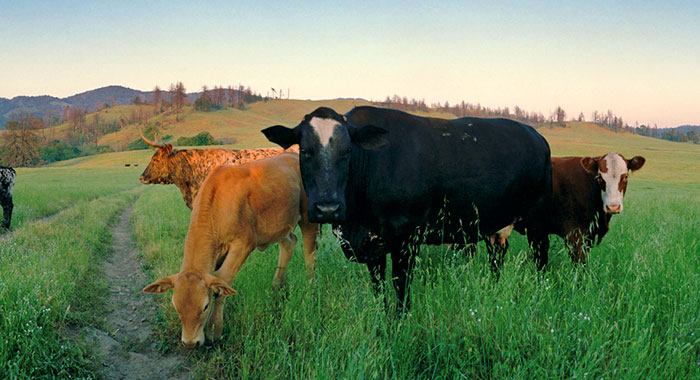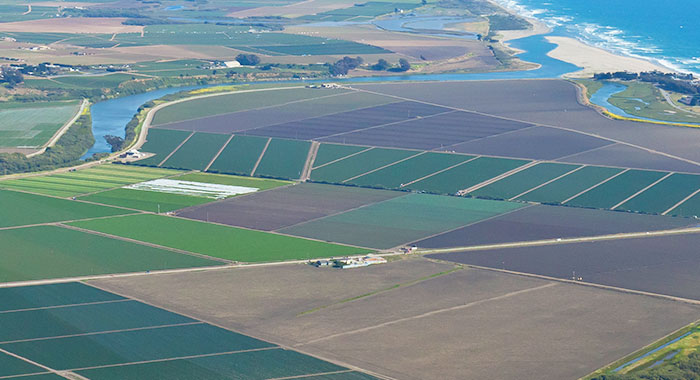In California, a day’s drive can take a visitor from record-setting desert heat to glaciated peaks to temperate rainforests with the world’s tallest trees. This astounding climatic and landscape diversity has helped create a biodiversity hotspot. California is also an economic hotspot – the 6th largest economy in the world – and is home to nearly 40 million people. The demand for land for new development and farms, along with accelerating climate change, puts tremendous stress on ecosystems, and the benefits they provide.
The state’s legacy of conservation has created a network of natural and working lands that benefit people by supplying clean water, capturing carbon, and directly contributing to the state’s economic and cultural vitality through recreation, tourism, and agricultural production. Conservancy scientists work across the spectrum of ecosystem types and human land uses, to advance conservation goals that also contribute to the well-being of people in those places.






Vickers, T.W., J. N. Sanchez, C. Johnson, S.A. Morrison, R. Botta, T. Smith, B.S. Cohen, P. Huber, W.M. Boyce
Conservation of wide-ranging species like mountain lions is especially difficult in highly fragmented landscapes, such as coastal southern California. Research into their populations can provide…Jennifer K. Carah, Jeanette K. Howard, Sally E. Thompson, Anne G. Short Gianotti, Scott D. Bauer, Stephanie M. Carlson, David N. Dralle, Mourad W. Gabriel, Lisa L. Hulette, Brian J. Johnson, Curtis A. Knight, Sarah J. Kupferberg, Stefanie L. Martin, Rosamond L. Naylor, Mary E. Power
Marijuana cultivation can have significant negative collateral effects on the environment that are often unknown or overlooked. This study focuses on California, where by some estimates, 60–70%…The Nature Conservancy: Erica Brand, Laura Crane, Dick Cameron, Energy and Environmental Economics: Grace C. Wu, Nick Schlag
Integrating ecological data into long-term energy planning is critical to meet both California’s long term energy and conservation goals. This report assesses the potential trade-offs associated…M.G. Anderson, P.J. Comer, P. Beier, J.J. Lawler, C.A. Schloss, S. Buttrick, C. M. Albano, D. P. Faith
Incorporating geodiversity into conservation plans to ensure conservation actions are more resilient to climate change is appealing because it addresses the threat of climate change while avoiding the…Patrick J. Comer, Robert L. Pressey, Malcolm L. Hunter Jr., Carrie A. Schloss, Steven C. Buttrick, Nicole E. Heller, John M. Tirpak, Daniel P. Faith, Molly S. Cross, Mark L. Shaffer
The protection of biodiversity in a changing climate is a key challenge for conservation planners. Conserving a diversity of geophysical settings makes species and systems more resilient to climate…Tamara S. Wilson, Jason Sherba, Dick Cameron, Benjamin M Sleeter
Human land use will increasingly contribute to habitat loss and water shortages in California, given future population projections and associated land-use demand. Understanding how land-use change may…Miriam Tsalyuk, Maggi Kelly, Kevin Koy, Wayne M. Getz, H. Scott Butterfield
Monitoring the effects of grazing on rangelands is crucial for ensuring sustainable rangeland ecosystem function and maintaining conservation values. Residual dry matter (RDM), the dry grass…Langin, K.M., T.S. Sillett , W.C. Funk, S.A. Morrison, M.A. Desrosiers, C.K. Ghalambor
Islands are renowned laboratories for discovery into natural selection. This study looked at “islands” of habitat within a single island and remarkably found that the Island Scrub-Jay…Hofman, C.A., T. C. Rick, M. T. R. Hawkins, W. C. Funk, K. Ralls, C. L. Boser, P. W. Collins, T. J. Coonan, J. L. King, S.A. Morrison, S. D. Newsome, T. S. Sillett, R. C. Fleischer, J. E. Maldonado
Genomics techniques provide powerful means of understanding evolutionary history. This paper examines the evolution of the island fox, which occurs on six of the California Channel Islands. Insights…Doak, D.F., G.K. Himes Boor, V.J. Bakker, W.F. Morris, A. Louthan, S.A. Morrison, A. Stanley, L. Crowder
One of the key components of a recovery plan for a threatened or endangered species in the United States is the set of recovery criteria that will be used to evaluate progress in abating the threats…Katie Andrews, Megan Webb, Robin Cox
This interactive webmap takes a multimedia approach to showcase the Conservancy’s conservation legacy in Marin County, California. Eleven achievements are profiled with photographs and…Cause Hanna, Ida Naughton, Christina Boser, Ruben Alarcón, Keng-Lou, James Hung, David Holway
Floral visitation by ants can compromise plant reproduction in situations where ants interfere with more effective pollinators. This paper documents how Argentine ants on Santa Cruz Island in…Daniel Karp, Sasha Gennet, Rodd Kelsey
M.L. Mann, P. Berck, M.A. Moritz, E. Batllori, J.G. Baldwin, C.K. Gately, D.R. Cameron
Between 1940 and 2000, nearly 10 million housing units were constructed in California. This new development led to increased interaction between human and natural communities. Tha authors of this…Matt Miller, Dick Cameron
H.B. Ernest, T.W. Vickers, S.A. Morrison, M.R. Buchalski, W.M. Boyce
Highly fragmented landscapes can pose myriad threats to wide-ranging species like mountain lions. Coastal southern California has long been the focus of research into demographics, genetics, and…